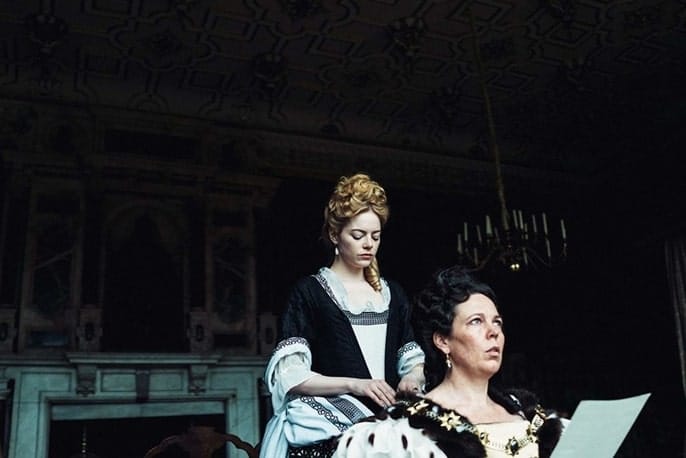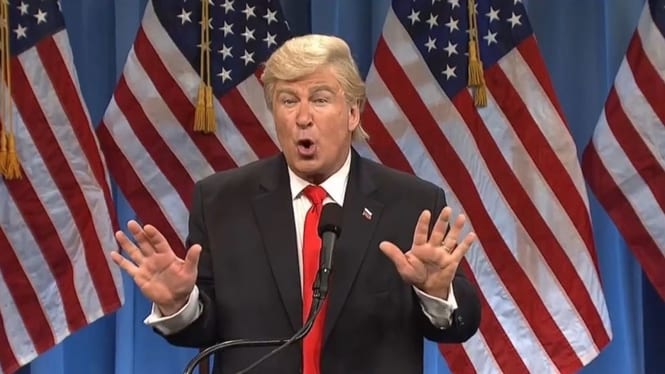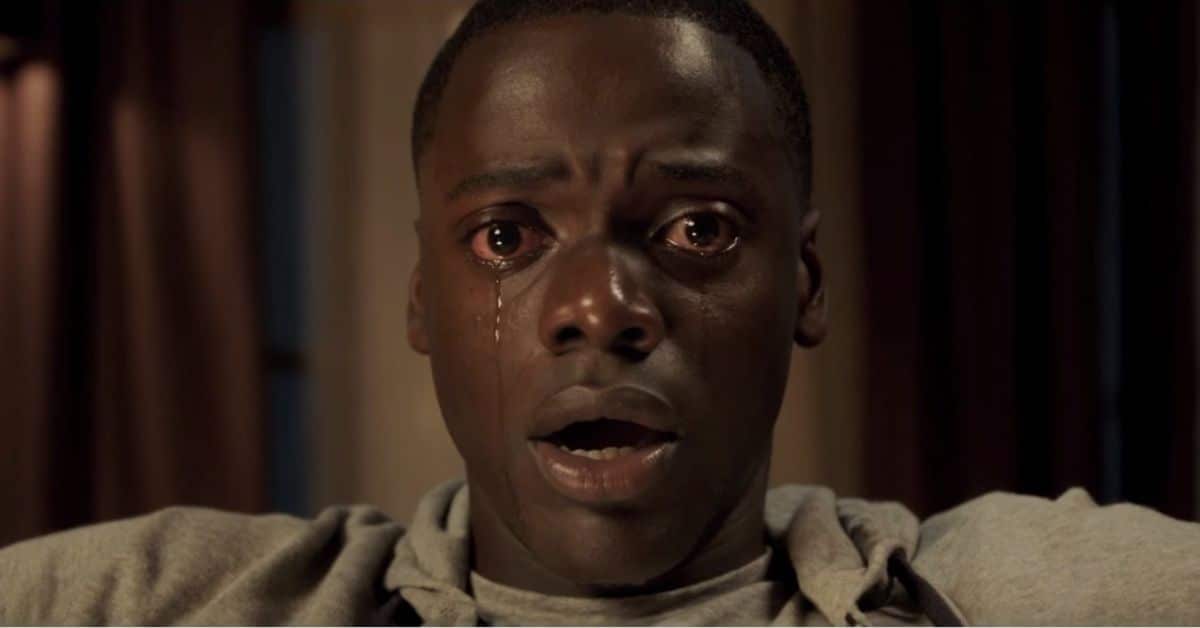Social satire is a genre of film that relies on irony, exaggeration, ridicule, or humor to critique an unfavorable aspect of society and/or human nature.
The best social satires are entertaining at the surface level – often featuring elements of fantasy or absurdism – and also pack a critical punch.
In this article, we’ll break down the key aspects of a social satire.
Warning: This post contains spoilers for GET OUT, SORRY TO BOTHER YOU, and FIGHT CLUB.
Table of Contents
What Issue Are You Satirizing in Your Social Satire?
A social satire revolves around whatever aspect of society it’s critiquing.
Therefore the first step of writing a social satire is determining what societal issue your script is going to satirize. Some possible topics might include:
- Politics – Power struggles, deception, and deceit in the political sphere.
- The Social Hierarchy – How society is structured, and how that structure often disadvantages people of certain races, classes, genders, sexualities, etc.
- Technology – How people communicate, how society is becoming increasingly reliant on technology, etc.
- The Environment – How humans affect the environment and their ignorance regarding their impact.
- Religion – The psychology of religion, the corrupt aspects of the institution, etc.
When choosing a topic for your social satire, it’s helpful to read the news and stay up to date with current events. You may even want to keep a journal where you take notes about societal trends that you notice (particularly those that you think should change) throughout everyday life.
The best social satires critique relevant subject matter. So allow the current state of the world to inform your choices as a writer.
Broad vs. Specific Satire

You may choose to critique a broader issue, like power/corruption (THE FAVOURITE) or classism (PARASITE). Such films primarily rely on other elements like style, setting, or characters to add nuance to the critique. Clearly, this can be effective.
But more specific or niche topics – when properly executed – will help distinguish your script from other social satires.
For example:
- Each BLACK MIRROR episode focuses on a particular aspect of modern technology and its impact on society. For example, “Nosedive” satirizes people’s over-reliance on social media, criticizing those who constantly seek validation through likes and ratings.
- THE LOBSTER is a satirical commentary on the social pressures that underlie the search for a lifelong romantic partner.
- LITTLE MISS SUNSHINE critiques society’s impractical standards of beauty, specifically satirizing the toxicity of beauty pageant culture.
Novel topics can add the necessary dose of originality to your social satire script. Of course, originality is an important aspect of any film regardless of its genre. But a social satire requires some degree of novelty to be fully effective.
A critique should open viewers’ eyes to an issue, or at least highlight some aspect of the issue largely unexplored in popular media. If the topic (or execution of the topic) feels jaded, the critique will fall flat. Your social satire should challenge viewers by presenting a new perspective.
But what differentiates a satire from a traditional critique? Films like IF BEALE STREET COULD TALK or FRUITVALE STATION, for example, critique racism in America without satirizing it. It’s essential to understand the key features of a social satire before delving into the writing process.
What Makes a Social Satire a Satire?
As previously mentioned, a satire uses irony, exaggeration, humor or ridicule to critique some aspect of society or human nature. Your script doesn’t need to incorporate every one of these devices, but it must use at least one to technically qualify as a satire.
Irony
Irony is an effective way to highlight hypocrisy, draw attention to the absurdity of an issue, or even just to elicit laughs from an audience.
There are three types of irony:
- Verbal irony occurs when a person says one thing but means something different, often the opposite. One of the most common forms of verbal irony is sarcasm.
- Dramatic irony takes place when audience members know information that the characters in the story don’t.
- Situational irony occurs when the expected outcome of an event or situation and the actual outcome don’t match.
Many genres of films use irony to make a commentary or to inject humor into a script, not just social satires. But it is particularly prevalent in social satires, as it’s a clever way to criticize society or human nature without feeling preachy.
In LITTLE MISS SUNSHINE, for instance, the beauty pageant audience is appalled by Olive’s silly dance routine. Yes, some of the moves are overtly sexual. But Olive is dressed like a child (even after she tears off her top layer), she’s bare-faced like a child, and she moves like a child.
Ironically, no one in the audience bats an eye when the scantily clad children who are made up to look like full-grown adults strut across the stage. The film therefore effectively uses irony to critique pageant culture and the sexualization of young girls.
But irony is not the only literary device that emphasizes the absurdity of a situation and draws attention to a critique. Exaggeration can serve a similar purpose, sometimes to an even more comedic effect.
Exaggeration
Exaggerated scenarios and characters make it easier to identify the topic being satirized and often force viewers to confront an uncomfortable truth. Almost every social satire features some amount of exaggeration:
- BLACK MIRROR is a hyperbolic take on modern society. For instance, “Fifteen Million Merits” exaggerates the flaws of consumerism – people ride stationary bikes to earn “merits” that pay for their daily needs. It also exaggerates technology’s role as a distraction in today’s world.
- Through Brad Pitt’s Tyler Durden, FIGHT CLUB exaggerates (and personifies) toxic masculinity.
- In ARRESTED DEVELOPMENT, a Bush-era satire, Lucille Bluth is an exaggerated depiction of a rich white conservative.
To effectively use exaggeration in your social satire, begin with a realistic issue. Take sexism, for example. Make sure you fully understand the nuances of the topic before brainstorming ways to exaggerate it.
One common way to over-dramatize an issue is to think about who it is affecting or disadvantaging. Who is the perpetrator and who is the victim? Continuing the sexism example, women are typically the ones who are oppressed and men are historically the oppressors.
A social satire might use hyperbolic characters or scenarios to exaggerate this dynamic and highlight its problematic nature.
Exaggeration can also be used to ridicule a subject, which is common in harsher critiques.
Ridicule
To understand how ridicule functions in a social satire, picture Alec Baldwin as Donald Trump. SATURDAY NIGHT LIVE is famous for ridiculing popular (and unpopular) celebrities and politicians.
But what exactly is ridicule and how does it relate to satire? According to Merriam-Webster, ridicule is…
“the act of making fun of someone or something in a cruel or harsh way”.
Cruel or harsh are the key words here. Clearly, ridicule won’t suit every social satire. But Juvenalian satire, one of the most abrasive types of satire, relies heavily on ridicule to deliver its critique. Juvenalian satires disdainfully and indignantly attack their subject matter and aim to spark anger in their audience.
Some examples of Juvenalian satires include:
- A CLOCKWORK ORANGE, which ridicules communism and behaviorism.
- AMERICAN PSYCHO, which ridicules consumerism and hypermasculinity.
Social satires that ridicule their subject matter are often more biting and can leave a longer-lasting impact.
But the best social satires typically don’t attack their subject too harshly. The goal of the critique shouldn’t necessarily be to draw blood or do any real damage, but rather to open viewers’ eyes to an issue.
Even if you’re condemning something that most people agree is wrong, an overly aggressive approach can make your audience defensive. A social satire should force viewers to look inward and accept their role (if any) in perpetuating the issue.
But it’s easy for a message to get lost amongst heavy-handed ridicule. Remember, social satire can be biting without being offensive.
This is not to say you shouldn’t be bold in your critique. Just keep in mind the goal you’re trying to achieve. If you’re striving for a more lighthearted social satire, you may opt to use humor rather than ridicule.

Humor
Most social satires – or any kind of satire, for that matter – utilize some degree of humor to critique their subject matter.
In a social satire, humor should contrast with the significance of the film’s message. This juxtaposition highlights the film’s central critique while also garnering laughs.
The three previously mentioned elements of a satire (irony, exaggeration, and ridicule) can all be used to a humorous effect. Here are some other ways to infuse humor into your social satire script:
- Incongruity, or a mismatch between a thing and its surroundings. Incongruity is a form of juxtaposition that typically results in humorously absurd situations. In SORRY TO BOTHER YOU, Cassius’s “white voice” is dubbed over by David Cross. The dubbing is very obvious, which makes it funny and incongruous.
- Inversion, where a script subverts a well-known situation or character type. For example, the Queen in THE FAVOURITE prefers playing with bunnies and racing ducks over ruling the country.
- Repetition, which is pretty much exactly what it sounds like: a repeating joke whose efficacy relies on audience recognition. There are countless examples in ARRESTED DEVELOPMENT, like Gene Parmesan fooling Lucille with disguises or Michael not recognizing George Michael’s girlfriend Ann.
- Slapstick humor, or physical humor. In THE FAVOURITE, characters fall out of carriages, throw shoes at one another, pretend to faint at Parliament meetings, and much more.
Although humor can be a great tool, not all social satires have to be laugh-out-loud funny. In fact, humor in social satires is often more subtle and offbeat.
Before writing, determine which elements of a satire you’re going to include (humor, exaggeration, irony, and/or ridicule) and also how you’re going to incorporate them. The delivery of the critique is as important as its topic, and it often involves devices like metaphors and fantasy elements.
Delivery of a Social Satire
The delivery of a critique refers to the techniques a writer uses to satirize their subject matter. If the topic of the critique is the “what,” the delivery is the “how.”
Metaphors/Allegories
Metaphors and allegories (extended metaphors) are two commonly used tools in social satires. They’re a simple and effective way to infuse deeper meaning into a story.
- In GET OUT, *spoiler alert* the liberal white elite transplant their brains into the “physically superior” bodies of kidnapped Black Americans. It’s an allegory of slavery and a commentary on the theft and exploitation of Black bodies.
- SORRY TO BOTHER YOU uses *spoiler alert* slave-like horse people as a not-so-subtle metaphor for capitalist culture.
- DISTRICT 9 is both a sci-fi alien blockbuster and an allegory of apartheid.
Metaphors and allegories create contrast between the absurdity of the film’s surface-level plot and the gravity of its underlying message. This contrast typically alerts the viewer to the fact that the film is a satire.
The best social satires don’t make their critiques too obvious, however. Viewers should have to work to connect what’s unfolding on screen with the statement the film is trying to make.
Metaphors and allegories can help a social satire script achieve the optimal balance between subtle and explicit critique. But a social satire should be more than its central metaphor – it should still feature interesting characters, believable conflict, and a structure that makes sense.
Viewers who don’t catch every intricacy of the metaphor should not only still follow the plot, but they should also be interested in it. So make sure your script isn’t all metaphor with no surface value.
If you think a metaphor or allegory suits your script, the next step is to determine what comparison you’re going to make and how you’re going to make it. Social satire metaphors often utilize absurd/outlandish/fantastical elements, which contrast with the film’s serious theme.
Elements of Fantasy

Satire and fantasy often go hand in hand. Non-realistic story elements not only provide an outlet for exaggeration and humor, but they also give writers more creative freedom in terms of the delivery of their critique.
- All three of the films mentioned in the metaphor/allegory section feature elements of fantasy: *spoiler alert* in GET OUT it’s the brain procedure, in SORRY TO BOTHER YOU it’s the horse-human hybrids, and in DISTRICT 9 it’s the aliens.
- In the world of THE LOBSTER, single people have 45 days to find a romantic partner before they’re turned into an animal of their choosing.
- Almost all of the technology in BLACK MIRROR – from the memory recorders in “The Entire History of You” to the virtual dating simulators in “Hang the DJ” – is fantasy (at least for now).
- BAD HAIR features a murderous hair weave as its antagonist.
In these examples, the fantasy elements add complexity to the critique by forcing viewers to ponder, “What if?” They help deliver the film’s message in a unique and thoughtful way while also ensuring that the surface level plot remains interesting.
Obviously, writers should not aimlessly toss elements of fantasy into their scripts. Everything must be purposeful. When planning how to use fantasy elements in your story, ask yourself:
- What purpose do they serve? They should be central to the critique, not thrown in as an afterthought.
- How do they improve the script’s critique or central metaphor/allegory (if there is one)?
- How will you make sure they don’t feel gimmicky?
While creatures like dragons, ghosts, and aliens exist externally in the fantasy world, fantasy elements can also be internal. Scripts that focus on internal conflict may rely heavier on psychological devices, like daydreams or hallucinations, to deliver their critiques.
Psychological Devices

Psychological devices give viewers a glimpse into a character’s head and add complexity to a social satire. Such devices are particularly useful in a script that satirizes an internal process, like imagination as an escape from the mundanity of daily life in THE SECRET LIFE OF WALTER MITTY.
In the context of this article, a psychological device refers to any narrative element that personifies or visually represents an internal mental process.
- In FIGHT CLUB, *spoiler alert* the narrator’s alter ego is a walking, talking character (portrayed by a separate actor) in the story.
- Adolf Hitler is a young boy’s imaginary friend in JOJO RABBIT, which satirizes the nazi regime. The film employs the psychological device to make a commentary on learned hatred and brainwashing.
- THE SECRET LIFE OF WALTER MITTY portrays the titular character’s daydreams in a series of adventure sequences.
Psychological devices will not work for every social satire, but they might be worth exploring if your script delves deep into an individual’s psyche. There are countless internal processes to satirize: greed, jealousy, prejudice… the list goes on.
Based on your topic, determine if a psychological device would make your critique more interesting or effective. If so, which device will you use (dreams, visions, alter egos, intrusive thoughts, etc.) and how will you visually represent it?
After reading this section, hopefully you have an idea of whether you want to use metaphors, fantasy elements, psychological devices, or all or neither in your script. But the devices you use to satirize your topic may ultimately depend on the subgenre of social satire you’re writing.
Social Satire Subgenres
Social satires can range from straightforward comedies like ARRESTED DEVELOPMENT and BORAT to horror flicks like BAD HAIR.
Other common subgenres include:
- Thrillers – THE HUNT satirizes the divide between liberals and conservatives in the United States.
- Science Fiction – See BLACK MIRROR, DISTRICT 9, and GET OUT.
- Romance – Think PRIDE AND PREJUDICE, which satirizes the idea that women should only care about marrying rich.
- War – DR. STRANGELOVE, a Cold War satire, and JOJO RABBIT both critique the follies of war.
Determining the subgenre of your social satire is a crucial part of the writing process.
In most cases, a film’s subgenre influences – and often even dictates – its tone. Think of a typical horror film; its tone is likely scary or unsettling. One of the beauties of social satires, however, is that their overall tone does not have to match the tone of their subject matter.
In fact, there usually should be some degree of tonal mismatch. For instance, JOJO RABBIT is essentially a comedy about the Second World War.
Such incongruity draws attention to the film’s central critique and is typically a major characteristic of social satires.
Combining Genres

Most social satires are a blend of multiple genres, which further complicates their tone.
For example:
- PARASITE is a thriller with hints of comedy.
- GET OUT is a combination of horror, science fiction, and comedy.
- THE LOBSTER is a dark, comedic, science fiction romance.
- SORRY TO BOTHER YOU is both a comedy and a fantasy.
Genre is a tool that facilitates the marketing process and also gives viewers or readers an idea of what to expect from a particular film or script.
People generally posit that a script should have a clear-cut genre so producers know how to market it. However, social satires flip this notion on its head. A mix of genres is not only acceptable, but it often elevates a social satire script.
Contrasting genres create a juxtaposition between the expected and the unexpected. In a social satire, the unexpected elements are typically the comedic ones. For example, viewers expect a horror film like GET OUT to be scary, but its humor may catch people by surprise.
Some films transition from one genre to another, which can also be a pleasant surprise. Think SORRY TO BOTHER YOU, which unexpectedly veers into the fantasy realm, or PARASITE, which transitions from a mildly comedic heist movie to a full-fledged thriller.
The blending of genres adds depth to a critique and keeps viewers on their toes. So think about which genres you might combine to maximize your critique’s efficacy.
But although your social satire may be a mixture of genres, it’s still important to pinpoint who your target audience is.
Knowing The Audience of Your Social Satire
If GET OUT’s target audience was wealthy white conservative retirees, it would be an entirely different film.
Instead, director Jordan Peele said GET OUT is primarily aimed toward black audiences – a demographic who is more likely to understand the film’s references, appreciate its critique of racism, and relate to the characters’ struggles.
Knowing your audience is a crucial aspect of writing an effective social satire. Its efficacy may even rest on its target audience. For instance, a Trump-era satire that is exclusively targeted at liberal college students likely won’t turn many heads or change many opinions.
While writing your social satire, ponder the following questions:
- Who is my target audience? Is it a broad group of people or a more specific population? Are there elements of my critique that will be lost on certain audiences?
- Is my target audience of the same demographic as the people I’m critiquing? If so, how will I open their eyes to an issue without coming off as overly condescending or offensive?
- Does my critique feature language, characters, situations, and conflicts that are relevant to my intended audience?
It’s important to include story elements, references, and overall themes that feel applicable and pertinent to your viewers. However, your goal should also be to appeal to as many people as possible. So if your target audience is narrow, try to think of ways to broaden it.
Perhaps you can add characters of varying demographics, play around with different narrators/point of views, or even sprinkle in references that people outside of your target audience might understand.
Anything that broadens your audience – without sacrificing the integrity of your critique, of course – will ultimately benefit your social satire script.

The Social Satire: A Conclusion
Social satires use irony, exaggeration, ridicule and/or humor to critique society or human nature. They typically balance multiple genres and tones to create an altogether unique viewing experience.
Remember, social satires should still be entertaining despite how heavy their underlying critique may be. In fact, the blend of genres and use of absurdism make social satires one of the most entertaining genres of film.
The most successful social satires balance humor with seriousness, surface-level plot with deeper meaning, and absurdism with realism. Balance is key, but it’s also important to be bold in your critique. Satire is all about making a statement.
Follow the tips in this article and you’ll be ready to make yours.
In Summary
Your topic should be relevant to the current state of the world. If the issue you’re critiquing is on the broader end of the spectrum, other story elements should add nuance to your script.
To be considered a social satire, a film must feature at least one of the following elements: irony, exaggeration, ridicule, and humor.
How a social satire delivers its critique is as important as the topic of the critique. Metaphors, allegories, fantasy elements, and psychological devices are all potential ingredients of a thought-provoking critique.
Most social satires are a mix of multiple subgenres, which makes for a complex tone. The blend of genres and tonal mismatch keep audiences on their toes and create a juxtaposition that highlights the film’s critique.
Most social satires are a mix of multiple subgenres, which makes for a complex tone. The blend of genres and tonal mismatch keeps audiences on their toes and creates a juxtaposition that highlights the film’s critique.
- What did you think of this article? Share It, Like It, give it a rating, and let us know your thoughts in the comments box further down…
- Struggling with a script or book? Story analysis is what we do, all day, every day… check out our range of script coverage services for writers & filmmakers.
This article was written by Alissa Evans and edited by IS Staff.
Get *ALL* our FREE Resources
Tackle the trickiest areas of screenwriting with our exclusive eBooks. Get all our FREE resources when you join 60,000 filmmakers on our mailing list!


I сould not refrain from ϲommenting. Well written!
Thanks! Glad you enjoyed the article.
That was pretty good but it would be interesting to hear the difference between social satire and black comedy. I think King of Comedy is both and a brilliant film.